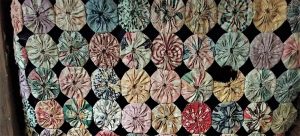
High Point’s Brad Flater grew up dreaming of designing boats. With a pedigree that includes
Hatteras Yachts, his OBX Boatworks has set its own brilliant course
By Ross Howell Jr. • Photographs by Sam Froelich
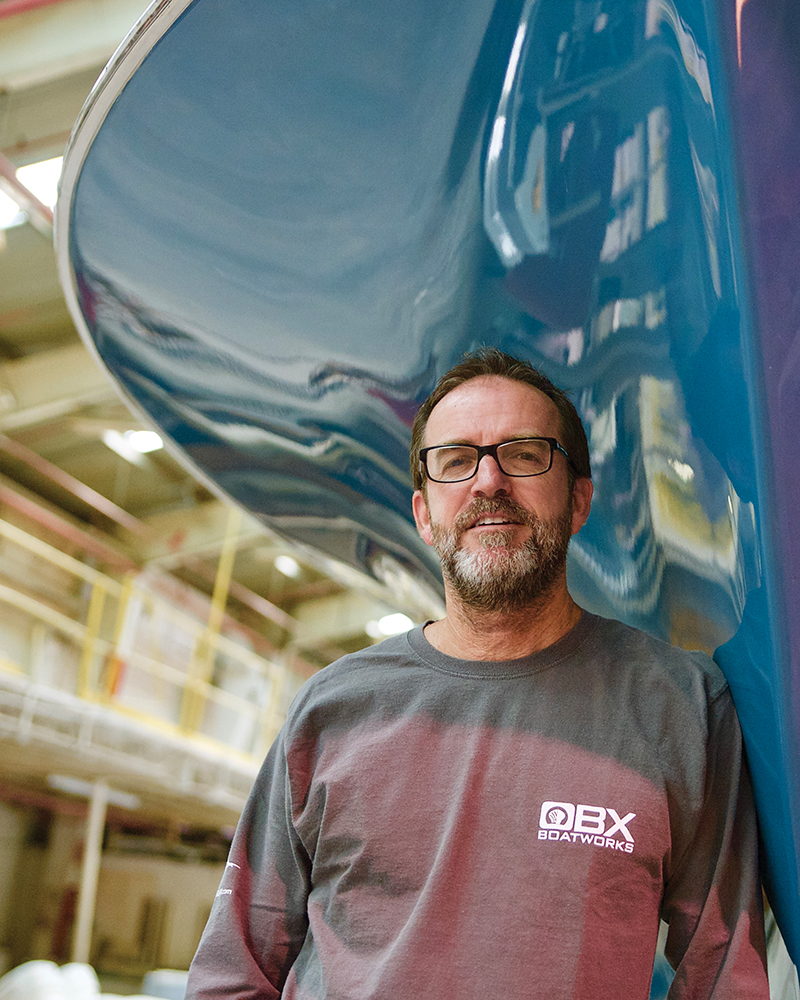
Since I’m a relative newcomer to Greensboro, the location for this story didn’t make sense to me. Wouldn’t a custom builder of sea-going yachts be situated near the ocean, on an estuary, or at least a river?
Yet here I am in High Point, turning off East Martin Luther King Jr. Drive onto Pendleton Street. I see clean white letters against the black background of a sign, “OBX Boatworks.” I pull into a parking space by the entrance. Before me rises a massive, metal-sided manufacturing structure.
I walk through glass doors into a warmly lit office with a big wooden table, modern chairs and attractive wall hangings. As the door closes behind me, a trim, youthful, bespectacled man stands up from a desk in the corner and approaches.
“Brad?” I ask.
“Yes,” Brad Flater — founder and owner of OBX Boatworks — says, smiling and shaking my hand. He has dark hair and a beard. He’s wearing a long-sleeve T-shirt and black denims. His eyes are bright and alert. His voice and manner are confident, genial, and immediately I feel at ease.
We sit at the table. I ask him about his business’s unlikely location.
“Yep,” he says. “High Point’s about as high and dry as it gets. But the facility we’re in, the whole structure, was built years ago by Hatteras Yachts to manufacture boats.” And the location was by no means accidental. “If you think about it, it makes a lot of sense,” he says. “The hulls were fiberglass, but the cabin and deck finishes are wood. With all the furniture makers nearby, with highly skilled cabinet makers and carpenters, Hatteras Yachts could sell boats finished with woodwork by some of the best craftsmen in the world.”
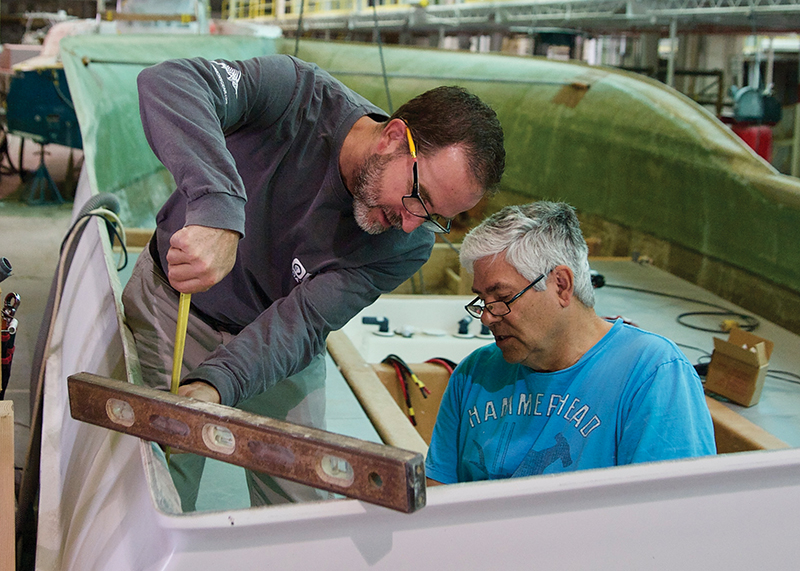
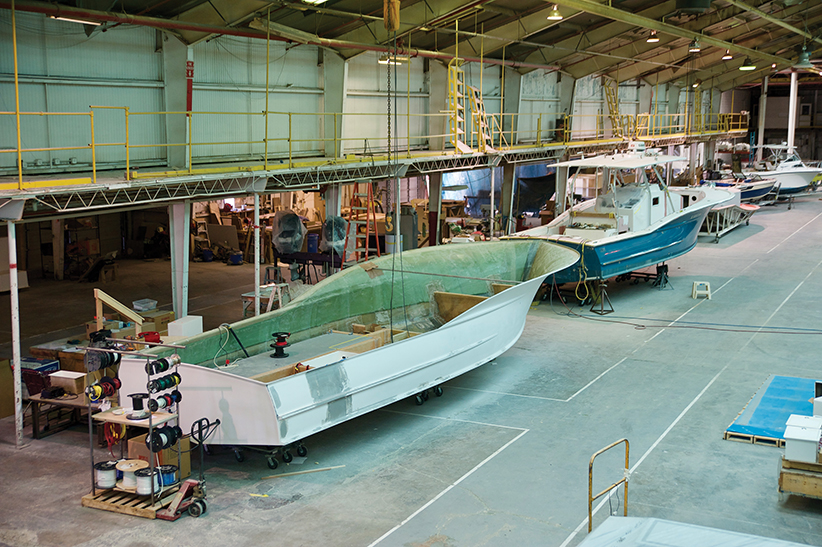
High Point native Willis Slane Jr. founded Hatteras Yachts in 1959, and his company remains a leader in the boat-building industry today. Slane had grown up in his family’s textile business, Slane Hosiery Mills, but became fascinated with the idea of developing a fiberglass boat that could cut through the prodigious winter waves off the coast of Hatteras when other boats had to stay in port.
In 1960 Hatteras Yachts introduced a 41-foot fiberglass boat, at the time, the largest ever manufactured. The company’s successful product launch was followed a year later by a legendary photograph taken of the devastation left in hurricane Carla’s wake in Corpus Christi, Texas. In the photo a lone boat floated at moor in port, while all the wooden boats tied alongside had been smashed to kindling. That boat had a fiberglass hull, and a manufacturing revolution was born.
“When I joined Hatteras in 1988, there were two manufacturing locations — one in this building, and one at the company’s current location, New Bern,” Flater says. “In High Point there were six production lines. My business now takes up just one of them. I’d say there were 600 to 800 employees in this building when I started working here. It was quite an operation.”
For Flater, building boats has been a lifelong dream.
“When I was a kid I was always drawing. My mom still claims the first thing she can remember me drawing is a boat,” he says.
“I grew up in Redlands, California, but I had family in the Midwest. My relatives ran a boat business in the Quad Cities on the Mississippi River, in Moline, Illinois. Just about every summer I’d be there, learning to rebuild an engine, or just tinkering around with boats.”
It was in high school that he decided he definitely wanted to become a boat builder: “My school guidance counselor couldn’t offer much advice on that subject. So I wrote letters to naval architects, asking how I might get started in the business.”
To his surprise, many of them wrote back. “They were candid. They told me it was a very tough business to get into. So I decided to do something more traditional. I enrolled to study architecture at Santa Monica College. It’s a good program, and it really improved my drafting skills.” After two years, he decided to change his tack: “I just couldn’t give up my passion for boats. I transferred to the Maine Maritime Academy. It’s a small school in the town of Castine on the coast of Maine. Geographically, that’s about as far from Santa Monica as you can go.” With about 950 students, Maine Maritime Academy is renowned for its hands-on learning programs and a remarkable employment rate for graduates.
“Members of my family had their doubts about such a radical change,” Flater says, “but I hopped in my Volkswagen — my family’s always had Volkswagens — and drove across country. In Castine I was able to concentrate on naval architecture, which is really interesting to me, because you’re building something that moves. So the discipline combines architecture with engineering.”
Flater muses for a moment.
“I guess you could say I was still a dreamer when I finished school,” he says. “I saw myself working in some fancy town like Annapolis, Maryland, on the water with boats everywhere. Instead I did an internship with Hatteras Yachts, and when the company offered me a job, honestly, for someone interested in boat-building in that time, it was like being offered a job by IBM.”
Alton Herndon, who served as president of Hatteras Yachts from 1985 to 1996 — and is still a nationally recognized leader in the marine industry — hired him. “He’s a real businessman’s businessman,” Flater says.
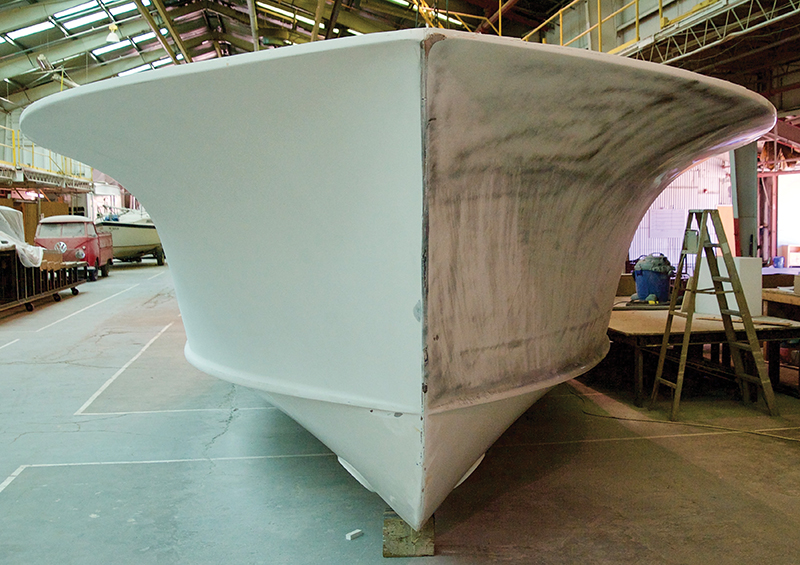
Herndon put Flater in charge of designing high-end, custom yachts. “The company’s custom yachts were boats 92 feet and longer, and they were all built in New Bern, so I commuted from High Point. One of our customers was Felix Sabates.”
Best-known for fielding NASCAR Sprint Car Racing teams, Sabates is also active in the boat business. He purchased a Stuart, Florida, Hatteras Yacht dealership and expanded it into one of the largest in the world.
“I built a few boats for Felix,” Flater says. “He’d sell them just as soon as he took delivery. He’s an unbelievable salesman. But I also built the boat he kept for his family.”
Flater smiles and pauses.
“Would you like to look around?” he asks.
He holds the door for me as we step into the area where the boats are built. Parked in front of us in a vintage Volkswagen pickup. I shake my head and grin.
“I told you about the Volkswagens,” he says.
“Haven’t seen one of those in a while,” I say. “Air-cooled, right?”
Flater nods.
“A ’59. I finally talked my grandfather into giving it up. He’s 92.”
In the big space the pickup is an anomaly, of course. The production building is a gigantic, neatly organized shoebox, about five times as long as it is wide. Down the line are overhead booms, catwalks and stepladders. Boat hulls and cabins of similar sizes stand about in varying conditions of completion. About halfway up the line, just to the side, are the halves of a big, splayed-out mold. It looks like a giant mollusk.
“That’s the mold we use to infuse the fiberglass for the Carolina hull,” Flater says. “We had to find a way to distinguish our boats from the competition. So we concentrate on building 32-foot, 36-foot, and 40-foot boats.” One of Flater’s beautifully designed, hand-crafted boats, with all the bells and whistles technology can offer, is for the serious owner — one can cost from $250,000 to as much as $3 million to purchase.
“Our boats are primarily for sport fishing. The Carolina hull is very efficient in the waters around here. It has excellent stability in what’s called ‘short chop,’ it handles heavy seas well, and with a shallow tumblehome and outboard motors, the boat gets outstanding speed and distance from a tank of fuel.” The boat, with its highly effective Carolina hull, is understandably popular with charter fishing operations.” “It’s very distinctive. It draws attention. Here,” Flater says. “Stand here, against the side.” He steps next to me and looks up.
“See?” he asks. “We say it’s not truly a Carolina hull unless you can get out of the rain under it.” He’s right. The flare provides shelter as wide as the eaves of a house.
The design was popularized by wooden boat builders long ago on the Outer Banks, in places like Wanchese and Harkers Island.
“I used to go to those places all the time,” Flater says. “The boat builders are amazing. In fact, Billy Dupree of Harkers Island built my ‘plug.’ That’s the original boat that’s used to form a mold.
“I had to invest a lot of money before I got anywhere near having a finished fiberglass boat I could market,” Flater continues. “I paid Billy to build a traditional plank-on-frame Carolina hull boat that we could use to cast the mold. Once the mold is made, that’s step one.” The succeeding steps before they had a finished fiberglass hull required a huge investment of time and money. “Since Billy’s boats are so beautiful, I was able to sell the plug and get back some of the original investment,” he recalls.
“Step two was making our first hull. We layer the fiberglass materials into the mold. Every one of our hulls has eleven layers. Then we infuse it.” The entire process can take a good two weeks, and the temperature must be carefully controlled so the fiberglass cures at the proper rate. “There are about $40,000 in materials for a hull, so we have to be sure to get it right.”
The result combines what’s worked in the past with materials and design that are cutting-edge. “I tell people in our boats we build ‘tradition with technology,’” Flater says. Taking advantage of advances made by the textile industry, Slater has turned to nanofibers. “It took some trial-and-error, but we now make our hulls using nanofibers in the resins. If you picture a strand of hair as a thick rope, a nanofiber beside it would be the thickness of a thread.” The material produces strength in numbers: “These tiny fibers not only make our hulls incredibly strong — they’re literally bullet-proof — but the fibers also reduce the noise level in the hulls, which is always an issue with fiberglass boats.”
We stop in front of a boat that looks finished. The hull is light blue and the helm and deck are white. The boat looks like it’s cutting effortlessly through waves, even though it’s static.
I follow Flater up a stepladder and stand on the deck. The helm gleams with polished metal and varnished teak. Screens for underwater sonar and navigation, and dials and switches I can only guess at crowd the instrument panel.
“This is our ‘express’ design, which means there’s more indoor space,” Flater says. “A customer sent the boat down for some upgrades. He’s a New York bond trader who lives on Long Island.” A dedicated fisherman, along with his sons, the owner is thinking about selling the boat. Why? “So we can build him a bigger one,” Slater says, “but he wanted us to change a few things before he decides whether he’ll put it on the market. Let’s take a look below.”
Slater opens the hatch and steps down into the cabin. There are two sleeping berths, a galley, and a built-in flat screen TV. He turns on the reading lights in the berths. He opens and closes a couple of cabinet doors. They’re teak, with geometric designs in the wood. Everything is exquisitely finished. When the cabinet doors are closed, it’s hard to see the seams.
“See why I like being near cabinet makers?” Flater asks.
I nod, my head cocked to the side because of the overhead.
“This customer is about my height,” Flater says. He’s around 5-foot-10, so he’s comfortably standing upright. “For someone your size, we’d build in more headspace,” he says. “Each of our boats is custom-made for the individual who’s buying it. That’s one of the things I like best about the business — the chance to work directly with customers.”
We exit the cabin. I take one more look around the deck, and we descend the ladder.
As we’re walking down the production line, I spot a hull that reminds me of the cigar boats — big and long powerful speedboats — I remember seeing in Miami.
“That’s a catamaran hull we’ve been developing,” Flater says. “Very efficient. It’ll do 72 mph with a 65 hp engine.”
Farther down the line, I follow Slater up a shorter ladder and take a long step over the top of the hull to the deck. Many of the appointments are sanded, showing the bare fiberglass. All the wooden fittings have been removed.
“This configuration is called a ‘center console’ design, which means there’s more outdoor space,” Flater says. “We’re changing around the deck for a guy who runs a charter operation.” The layout provides lots of room for anglers to fish from different locations. “Those are covers for fish-keeper wells under the deck, all custom-made to the customer’s specifications.”
Flater pats the side of an empty fiberglass cabinet.
“This is the special console we built to add a ‘Seakeeper,’” he says. “That’s a gyro device that turns 10,000 rpm and reduces roll motion.” It’s a big help if anybody on board has a problem with seasickness.
“We get our Seakeepers from Marine Tooling Technology,” Flater says. “They’re also in this building. The company is best-known for manufacturing fiberglass molds. They also do fiberglass repair, make custom parts, and supply marine technology.”
From the deck of the boat Flater looks down the production line, watching as a workman spray-paints a custom fiberglass panel.
“Unfortunately, this property is for sale,” he says. “But fortunately for us, since the building was constructed specifically for boat-building, it’s hard to re-configure for other uses. That’s made potential buyers cautious.
“It would be hard for us to find another facility so well suited to boat-building,” he continues. “So we’re looking into getting some development help to acquire the property and turn the whole building into a marine center, with different suppliers and manufacturers located here. Wouldn’t it be cool if we could get the old Hatteras Yacht manufacturing site fully involved in boat-building, like back in the company’s heyday?”
Given the tenacity and vision Brad Flater has shown realizing his boyhood dream, I’d bet money he’ll realize this one, too. OH
A mountain boy, Ross Howell Jr. is not a sailor, though he loves the sea.



